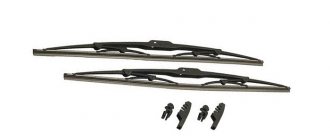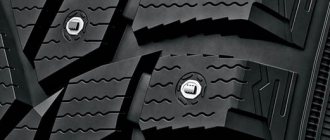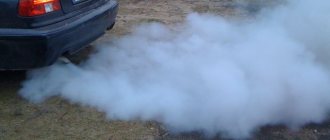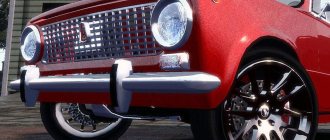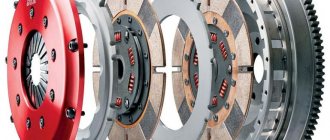The crankshaft is made of either cast iron or alloy steel, both materials are quite strong, but defects still arise over time, and repair dimensions of crankshafts . These are peculiar tolerances to which the thickness of the necks can be reduced without severely compromising the strength of the part. And, since the journals usually interact with the bearings, the latter are provided with liners with repair reduction.
What are the repair dimensions of crankshafts for? – AutoDoza – Automotive portal
The crankshaft is made of either cast iron or alloy steel; both materials are quite strong, but defects still arise over time, and repair dimensions of the crankshafts are needed to eliminate them.
These are peculiar tolerances to which the thickness of the necks can be reduced without severely compromising the strength of the part. And, since the journals usually interact with the bearings, the latter are provided with liners with repair reduction. First of all, let's look at the different types of defects that occur, as well as the reasons for their occurrence. If the geometry of the seats for the support bearings of the block is broken, rapid wear of the journals should be expected. In other words, if this process is observed, the reason is most likely exactly the same as indicated above, or in the poor quality of the material of the shaft itself. Due to poor-quality oil or its irregular replacement, scuffs may appear on the necks; a clogged oil filter, or, which is even worse, low pressure in the system, can also be the source of this trouble.
There are two types of crankshaft journals - support and connecting rod. The latter, as the name implies, are designed to transmit the translational movements of the connecting rod to the knees, thus transforming them into torque. In essence, this is the principle of a well gate, or more precisely, its curved handle, in relation to which the human forearm can be considered a connecting rod. In a standard engine, the dimensions of the crankshaft journals correspond to 47.8 millimeters. It is logical that both the bearings and connecting rod rings are also adjusted to this size. However, the sports type of crankshaft is an exception; its journals have a diameter of only 43 millimeters, which means it requires special bearing shells and the installation of appropriate connecting rods.
When you are planning to grind the shaft journals, take care of the inserts in advance; during the first repair, they can be used with a reduction of 0.25 millimeters. If necessary, subsequent repair dimensions of the crankshaft journals can be changed to 0.5, 0.75 and 1 millimeter; the corresponding liners must also be purchased. Subsequent grinding is associated with a direct risk of shaft destruction during operation; for this reason, liner sizes 1.25 and 1.5 are extremely difficult to find.
Camshaft and its drive
The camshaft of the 21213 engine differs from the 2121 in a different angular arrangement of the cams, since the 21213 engine has different valve timing.
The camshaft drive has special features in repairing the chain tensioner. Its plunger is kept from falling out of the body not by a locking ring (as on 2121 engines), but by punching the body at three points. To disassemble the tensioner, file the edges of the body at the core points. After installing the plunger tensioner into the housing, it is necessary to open the housing at three points. In this case, the protrusions from the core should not touch the surface when the plunger moves.
KamAZ 740 crankshaft, Characteristics of the KamAZ 740 crankshaft and repair dimensions.
Peugeot 405 1.6 XU5JP Logbook New piston rings and repair of crankshaft thrust half-rings
The KamAZ 740 crankshaft is made of high-carbon steel by hot stamping and is also strengthened by nitriding or hardening with high frequency currents (HFC). The connecting rod and main journals are subjected to hardening. The KamAZ 740 crankshaft has four connecting rod journals and five main bearings that connect the jaws. The crankpins of the shaft are made in such a way that they have cavities inside that are closed with plugs. The cavities are designed for additional oil purification through centrifugal forces.
To balance the centrifugal forces, counterweights are installed on the so-called nose (the front end of the crankshaft) and the shank (the rear end of the crankshaft), which on the cheeks are integral with the shaft, and are pressed onto the nose at the time of assembly and secured using a segment key.
The oil pump drive gear is fixed at the front end of the crankshaft; it is the drive gear, and at the shank (rear end) there is a distribution gear with an oil deflector. In the front part (nose) of the crankshaft there are holes used for installing the coupling half. In the front part of the shank there are two holes intended for pressing in the pins securing the flywheel, an axial hole for the support bearing of the gearbox input shaft and threaded holes for the flywheel mounting bolts.
The possibility of axial displacements is eliminated by fixing the shaft using four thrust steel-aluminum half-rings, which are installed in the recesses of the engine crankcase and the main support cover. On the rear part (on the shank), the crankshaft is sealed with an oil seal pressed into the flywheel housing.
The role of connecting rod and main bearings is performed by the liner, which are installed in the so-called beds. Both main and connecting rod bearings are made of steel strip, which is coated with a layer of lead bronze. In the main bearings, the upper and lower parts are not interchangeable, since the upper parts have holes for supplying oil and grooves for distributing it. But the halves of the connecting rod bearings are interchangeable.
During engine operation, the KamAZ crankshaft journals wear out, and it is allowed to be ground four times, and the liners are available in seven repair sizes.
But another feature of the KamAZ crankshaft is that the block and connecting rods can also be bored to size.
Repair dimensions of crankshaft journals and bearing beds
| Connecting rod bearing | Main bearing | ||||
| diameter, mm | liner marking | diameter, mm | upper (lower) liner marking | ||
| crankshaft journals | connecting rod bed | crankshaft journals | bed block | ||
| 79,50-0,013 | 85,0+0,01 | 740.1004058 P1 79.50—85.0 | 94,5-0,015 | 100,0+0,021 | 740.1005170 (740.1005171) Р1 94.50—100.0 |
| 79.00-0,013 | 85,0-0,01 | 740.1004058 Р2 79.00 | 94,0-0,015 | 100,0 -0,21 | 740.1005170 (740.1005171) Р2 94.00—100.0 |
| 80,00-0,013 | 85,5+0,01 | 740.1004058 RZ 80.00—85.00 | 95.O-0.015 | 100,5+0,021 | 740.1005170 (740.1005171) RZ 95.00—100.5 |
| 79,50-0,013 | 85,5+0,01 | 740.1004058 P4 79.50—85.5 | 94,50-0,015 | 100,5+0,021 | 740.1005170 (740.1005171) Р4 94.50—100.5 |
| 79,00-0,013 | 85,5+0,01 | 740.1004058 P5 79.00—85.0 | 94,0-0,015 | 100,5+0,021 | 740.1005170 (740.1005171) P5 94.00—100.5 |
| 78.5О-0.013 | 85,0+0,01 | 740.1004058 P6 78.50—85.00 | 93,50-0,015 | 100,0+0,021 | 740.1005170 (740.1005171) Р6 93.50—100.0 |
| 78,00-0,013 | 85,0+0,01 | 740.1004058 P7 78.00—85.0 | 93.O-0.015 | 100,0+0,021 | 740.1005170 (740.1005171) Р7 93.00—100.0 |
Marks of the repair size and diameters of the crankshaft journals and beds in the block or connecting rod are applied to the back side of the liner not far from the parting plane.
The flywheel (Fig. 2) is necessary to accumulate kinetic energy during the power stroke and rotation of the crankshaft during auxiliary strokes, as well as to remove the piston from dead points and reduce the unevenness of shaft rotation.
The flywheel is cast from special gray cast iron. It is secured to the rear end of the crankshaft with eight bolts 3 made of alloy steel. Precise fixation of the flywheel on the crankshaft is achieved using two locating pins pressed into the end of the crankshaft. A ring gear 1 is pressed onto the machined cylindrical surface of the flywheel, intended for connection with the starter shaft gear when starting the engine. The clutch is installed at the rear end of the flywheel. To regulate the engine, there is a groove on the flywheel for flywheel lock 2 and 12 holes for turning the crankshaft with a crowbar.
The crankshaft clamps the shaft on the liners
I bore crankshafts from trusted boring companies, and I don’t experience any problems when assembling the engine. But if you bored the crankshaft and the boring machine made a mistake, and the crankshaft is clamped by the liners, or, on the contrary, is very loose, then a problem arises in installing the crankshaft on the engine.
I’ll tell you how to fix it if the crankshaft is clamped by liners, both on the main journals and on the connecting rods.
But first you need to install the liners correctly in the bed of the engine block, since if you install the liners incorrectly, the engine will jam, the photo shows how the liners should be installed correctly on a VAZ engine. But other engines also have liners installed.
Photo. Shows how to correctly install liners into the engine block.
After the liners are installed in the engine block, it is necessary to correctly install and select the thrust half-rings or rings (depending on the engine), in short, it is advisable to install or adjust the thrust half-rings so that there is no longitudinal movement of the crankshaft.
The essence of the problem with ring sizes on Aliexpress
VAZ 2109 hood size
Considering that Aliexpress is an international platform and sells its goods in the Russian Federation, the USA, and Europe, the sizing charts of goods must comply with regional standards. The question arises - what ring size is indicated in the lot, in what international standard? And how can we convert this size into one that is familiar to us, buyers from Russia?
An additional complication stems from the traditional Chinese laissez-faire attitude toward the characteristics of their products. Especially if the product is not expensive, such as rings not made of precious metals. How to find out the exact ring size, not plus or minus a centimeter?
What are the sizes of rings in general (and what is the difference)
In Russia, the indicated ring size is its internal diameter in millimeters.
In Europe there are several internal standards, but now in most stores you can find out the size as the length of the inner circumference in the same millimeters. Accordingly, the European size is easily recognizable in the lot on Aliexpress. European size starts with numbers around 40 mm, and Russian ring sizes are numbers from 14 to 22. And it is easy to recalculate, ring circumference (European size) = 3.14*ring diameter (Russian size).
The situation is worse with English, American and Japanese ring sizes. The British generally use the letters of their alphabet to designate ring sizes. As a result, there is not enough mathematics to translate these dimensions. Ring size tables are used to determine compliance. They are not difficult to find on the Internet and we won’t bother you with it here. Let us present only one short table.
If I install a new crankshaft, do I need to change the connecting rods?
If the connecting rods did not knock and the liners did not turn in them, feel free to leave the old connecting rods. The connecting rod must be changed if the liner in it has turned; if the connecting rod has knocked, but the liner has not turned, you can safely put the connecting rod back. When the liner in the connecting rod rotates, it gnaws out part of the metal, then the connecting rod must be thrown out and replaced with a new one. And if the liner in the connecting rod does not rotate, its size remains normal, and you can safely put it back. This is my personal experience over more than 20 years of practice in engine repair.
How to correctly determine ring sizes on Aliexpress.
Is it possible to find out the vehicle's equipment by looking at the fault code? How to find out the car's equipment
Ring sizes on Aliexpress for all sellers without exception are expressed in the American measurement system.
In order to choose the right ring size for yourself, you need to look at the ring size correspondence table offered by the seller in the product card. If you know your standard Russian ring size, then a simple and clear size table will tell you whether it corresponds to the American size. To do this, just select the Russian size, which is equal to the circumference of the finger in mm.
Otherwise, buyer will have to measure the finger circumference by themselves as shown in the pictures. The images may differ from one seller to another, but the procedure itself remains the same. You need to take a piece of thread or a narrow strip of paper and wrap it around your finger. Next, you should mark the circumference of your finger with a marker and lay a thread or paper with a mark to the ruler. Substitute the resulting number in mm into the table and determine the correct ring size.
What should you pay attention to when independently measuring your finger circumference? On the shape of your own fingers and the quite logical difference in the methods of measuring ring size in different Aliexpress stores. One Chinese store may offer to measure the circumference of the finger joint, another - the circumference of the phalanx under the finger
It’s better to take measurements of both, and then choose the greatest result. Otherwise, the purchased ring will either not fit on your finger, or it will be very difficult to remove.
By the way, the table of ring sizing charts from different sellers is slightly different. There's nothing to be done, China is China. Therefore, in order to determine your ring size, you can either choose the average value of ring size indicators, or use the grid offered by a specific seller.
Buying different types of rings requires an individual approach. It's good if your choice is a ring with a changeable size. Then you won’t have to fool yourself with determining the correct size, but simply bend the rim of the ring a little.
And when buying a Chinese copy of a very original Cartier Trinity triple engagement ring, you will have to choose one size larger than yours. This is required by the design features of the ring - three thin bands of yellow, white and pink colors are connected to each other in a special way. Each ring individually may fit you perfectly, but the rings that fit into each other will be too small for you because of this connection. In order to freely put on and take off such a ring without feeling discomfort, an additional size is required.
Before you finally decide on the size and choose a ring, you should also read customer reviews and, just in case, consult with the seller about the correspondence of the size chart to the actual dimensions of the product.
https://youtube.com/watch?v=PYg0aKo4k8k
Crankshaft loose
The crankshaft driller may make a mistake and loosen the crankshaft, then the engine will not have good oil pressure, and also because of this the engine may knock quickly.
Photo. This way you can turn the crankshaft on a VAZ engine with a key.
You can check for weakness in the crankshaft like this. Tighten the cushion and spin the crankshaft; if it spins very easily, it doesn’t hurt to check whether the crankshaft is loose or not.
Usually, after a good boring, the crankshaft does not clamp and turns easily. Remove the cushion, take out the liner and place chocolate foil under the liner, tighten the liner, if the crankshaft gets tight or starts to turn noticeably more difficult, it means that this crankshaft journal is bored perfectly, pull out the foil from under the liner and check the next pillow.
Photo. It is shown how to place foil under the liner, and be sure to cut off the excess foil with the tip of a knife; it is shown here that the foil is cut off on one side and not on the other.
If, after placing foil under the liner, the crankshaft does not turn more difficult, it means that this crankshaft journal is weakened, place more foil under this cushion between the liner until the crankshaft begins to turn more difficult. After all the pillows have been checked and found to be loose, and if more than one foil had to be placed under the liner, then you will have to completely remove the crankshaft and under those journals that had to be placed more than one foil, you will need to divide the foil strips into two and place half of the foil under the liner in the block. Install the crankshaft, tighten it, that's it, you have perfectly adjusted the liners, and the crankshaft will work perfectly in the engine.
Be sure to put a nail in the foil under the liner and make a hole through the holes in the liner for the oil to pass through.
Assembly of the crankshaft with bearings after repair
The shaft journal-bearing assembly is assembled on the principle of complete interchangeability.
To ensure complete interchangeability of parts of an assembly unit, during manufacture or restoration it is necessary to process both the crankshaft journal and the bearing with certain accuracy standards that determine the tolerance range of the parts.
If, when processing a batch of parts with a tool configured for size, deviations from size are formed under the influence of a large number of independent or weakly dependent random factors, then their distribution curve corresponds to the normal law or the Gaussian curve. For the normal distribution law, from the conditions of complete interchangeability, the tolerance is taken equal to ±3 σ
, i.e.
6 σ
(
σ
– standard deviation).
Table 5.1
Initial data for assembly calculations
crankshaft with bearings
| Diesel brand | Repair shaft diameter dр, mm | Maximum deviations of the shaft journal size, mm | Maximum error deviations K | Installation gap value, mm | Limit deviations of bearing diameter, mm | ||
| Smax | Smin | ES(Dp) | EI(Dp) | ||||
| Upper es(dp) | Lower ei(dp) | ||||||
| 6ChSP18/22 | Indigenous 134,536 | -0,025 | ±2,5 | 0,16 | 0,12 | +0,2 | +0,1 |
Let us determine the number of crankshaft journals in a batch of 200 pieces, the deviations of which are within ±2.5 σ
:
From Table 6.1 we find that Ф
(2.5) = 0.09275, and since the Gaussian curve is symmetrical with respect to the arithmetic mean size, then 2
Ф
(2.5) = 0.1855. It follows that 86.64% of the necks have specified deviation limits.
Their number will be equal to:
Tolerance for neck processing:
Since the curve is symmetrical, the arithmetic mean is:
Deviation values for the diameter of parts are within ±1.5 σ
:
Thus, 37 parts from a batch of 200 pieces will have dimensions within
with a tolerance of 0.02 mm.
Maximum deviations of the bearing diameter, ensuring the assembly of the unit according to the principle of complete interchangeability:
EI
and
ei
– lower limit deviations of the bearing and shaft journal, mm;
ES
and
es
– upper limit deviations of the bearing and shaft journal, mm;
Smax ( M ) _
and
S min ( M )
– maximum and minimum values of the installation gap, mm;
Arithmetic mean diameter:
Standard deviation:
Distribution coefficient:
Integral value:
From Table 6.1 we find that Ф(К 1 )
=0.2257, and
Ф(К 2 )
=0.4641.
Subtraction gives the relative number of parts in a batch with deviations from K1 to K2.
Number of bearings that provide the required assembly conditions with the shaft journals:
.
Characteristics of crankshafts
Characteristics of crankshafts photo, Instructions for engine modification, engine tuning
Of course, it is difficult to single out any of the most important parts in a car, but the crankshaft can be considered one of the most important, because it is the one that converts the forces from the pistons and connecting rods into torque, which moves the car.
In this article we will look at some parameters of crankshafts for “classics” and the features of their replacement and installation.
So, “classic” crankshafts have several parameters that may differ.
1. Crankshaft stroke - the distance between the axes of the connecting rod journal at bottom dead center (BDC) and top dead center (TDC)
On classic engines, the factory installed crankshafts with a stroke of 66 mm, 80 mm and 84 mm. In addition to them, there are sports crankshafts with a piston stroke of 86 mm, 88 mm and even 90 mm. However, you should not think that by installing a crankshaft with a stroke of 90 mm in the block, the engine will immediately become much more powerful. The behavior of the engine is greatly influenced by the ratio of the length of the connecting rod and the stroke of the crankshaft - the so-called R/S. Many people believe that the “golden mean” of a cylinder block is an R/S value of 1.75.
If R/S is large, then the piston remains at TDC longer, therefore more complete combustion of the fuel mixture occurs, hence greater pressure on the piston after passing TDC. The result is good torque at medium and high speeds. Also, a long connecting rod reduces its friction against the crankshaft. However, there are also disadvantages - with a long connecting rod and a short stroke, due to a decrease in air flow speed (again due to the lower piston speed after TDC), good filling of the cylinders at low and medium crankshaft speeds is not ensured. There is also a high probability of detonation due to the high temperature in the combustion chamber and the long time the piston remains at TDC.
If R/S is small, then a very good cylinder filling rate is ensured at low and medium crankshaft speeds, and also due to the short time spent at TDC (and therefore the higher piston speed at the beginning of the stroke), the mixture becomes more homogeneous, which contributes to better combustion. But there are also disadvantages here - a small R/S value means a larger angle of inclination of the connecting rod. Therefore, a large force will push the piston in a horizontal plane. Therefore, the load on the connecting rod, on the walls of the cylinder block, and the pistons of the ring increases, the operating temperature increases due to increased friction, and lubrication deteriorates. Well, due to the increased piston speed, the engine life is also reduced.
Another common problem when installing a crankshaft with a long stroke is the connecting rod touching the block wall. In this case, you need to refine the wall using a grinder or grinder.
2. Crankpin size
The crankshaft journal is a support with which the shaft is connected to the connecting rods.
The standard connecting rod journal diameter in a “classic” engine is 47.8 mm. The rolling bearings and connecting rods are also made to this size, however, on “sports” crankshafts with a stroke of 86 mm, 88 mm and 90 mm, the diameter of the connecting rod journal can be 43 mm. It requires special liners, as well as connecting rods, don’t forget about it!
3. Number of counterweights
Counterweights provide unloading of the main bearings from the centrifugal forces of inertia of the unbalanced masses of the crank and the lower part of the connecting rod. On standard crankshafts 2101 2103 there are only 4 counterweights, essentially on one side on the cheek (the main and connecting rod journals are connected) from the main support. On the remaining crankshafts 21213 and with a stroke of 86 mm, 88 mm, 90 mm there are already 8 of them, which ensures a more balanced unloading of the main bearings from inertial forces.
Crankshaft 2103 with four counterweights
Crankshaft 21213 with eight counterweights
| Sports camshafts Sports camshafts |
| Multi-throttle intake Multi-throttle power system |
| Direct exhaust systems Direct exhaust systems |
Spider 4-2-1 or 4-1 Spider choice 4-2-1 or 4-1 |
Characteristics of camshafts Characteristics of camshafts |
| Characteristics of crankshafts Characteristics of crankshafts |
| Methods for modifying the cylinder block Modification of the engine cylinder block |
Lightweight crankshaft Lightweight crankshaft |
| Forged pistons Advantages of forged pistons |
| Split camshaft gear Split camshaft gear |
| Sports receiver Sports receiver |
| Comparison of fuel pumps Which fuel pump to choose |
| Zero resistance air filters Zero resistance air filters |


